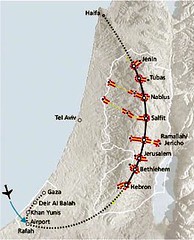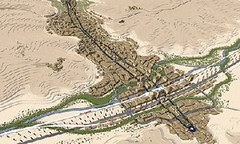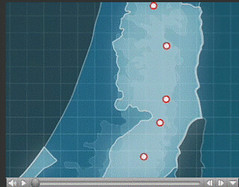Daring to imagine peace: a bold plan for Palestine's infrastructure and growth

Posted January 2, 2009 at 1:42PM
As I write, Gaza is under intense bombardment, over 400 residents have been killed, and things could hardly look worse for Palestine. (On edit, Jan 5: I wrote this on the evening of January 1. The situation has evolved and intensified since then, but the points still apply.)
But it also seems important and timely to recall a bold "what if" plan developed three years ago by Suisman Urban Design for the RAND Corporation that dares to imagine what the role of transit and urban planning could be in a peaceful and independent Palestinian state. The winner of all sorts of planning awards, The Arc: A Formal Structure for a Palestinian State is built upon a new transit corridor linking the major West Bank cities to each other and to Gaza.
 According to Suisman's web site, the Arc is a vision for connecting existing Palestinian urban centers with a series of new development areas along the rail line, providing a framework for significant population growth. In addition to high-speed rail, the Arc could include an aqueduct, energy generation (primarily renewables) and transmission lines, telecommunications lines, and a national linear park. Each of the infrastructure elements could also have planned east-west lateral branches that create the framework for compact, non-sprawling linear development in each urban area.
According to Suisman's web site, the Arc is a vision for connecting existing Palestinian urban centers with a series of new development areas along the rail line, providing a framework for significant population growth. In addition to high-speed rail, the Arc could include an aqueduct, energy generation (primarily renewables) and transmission lines, telecommunications lines, and a national linear park. Each of the infrastructure elements could also have planned east-west lateral branches that create the framework for compact, non-sprawling linear development in each urban area.
RAND conceived the project as "an object of hope to all who have sought peaceful resolution of the Israeli-Palestinian conflict." The 140-mile corridor could act as a catalyst to generate housing, jobs and business development, says RAND:
"Construction of the Arc would create an estimated 100,000 to 160,000 jobs for Palestinians over five years, on top of thousands more jobs in new businesses built along the corridor. It would also foster revitalization of historic city centers and preserve forests, nature reserves and agricultural land."
 Many of the elements of the Arc will be familiar to students of smart growth. More from RAND:
Many of the elements of the Arc will be familiar to students of smart growth. More from RAND:
"The Palestinian population of about 3.6 million in the West Bank and Gaza is expected to grow to roughly 6.6 million by 2020 due to natural population growth and immigration. The Arc would link the major towns and cities of Palestine - including Nablus, Ramallah, Jerusalem, Hebron, and Gaza City - making it possible to travel from southern Gaza to the northern West Bank in less than 90 minutes. Each rail station, located several miles from existing historic urban cores, would create a focal point for new development and would connect to a historic core via a new boulevard and an advanced form of bus rapid transit.
"Along each boulevard, new commercial and residential neighborhoods would be developed - largely by private sector investment - to accommodate population growth. Housing and jobs would be created within walking distance of the transit system. New building design would incorporate sustainable systems using solar energy and recaptured water. Development along each boulevard would pump economic activity into the historic centers of Palestinian cities and assure their preservation and revitalization - an essential strategy for creating a much-needed tourism industry.
"In addition to creating a ladder of linear cities along the defining mountain ridge of the West Bank, the Arc would preserve open land for agriculture, forests, parks and nature reserves. A national park following the line of the Arc would provide needed recreation space within each city, and a path for hiking and biking between municipal areas. A parallel toll road would provide access for trucks and other vehicles for people and freight, linking the country to its economic gateways at a possible airport and seaport in Gaza."
Suisman and RAND's recommendations could be implemented for approximately $33 billion in capital investment in the first 10 years of a new state, according to the authors of the Arc reports.. RAND says that the resulting annual average of about $760 per person is broadly comparable with other recent nation-building efforts.
If you click on the image below (or go here), there is a short and interesting video clip from Suisman on the project:
In addition, NPR in mid-2005 ran an interview with RAND's Stephen Simon discussing how the Arc could serve as a framework for international assistance to a hypothetical Palestinian state as well as the necessary preconditions before the plan could become a reality. NPR also has an associated story and some related links here.
We can dream, at least. And I'm glad the principals behind this intriguing, if tragically elusive, goal have been doing just that.
